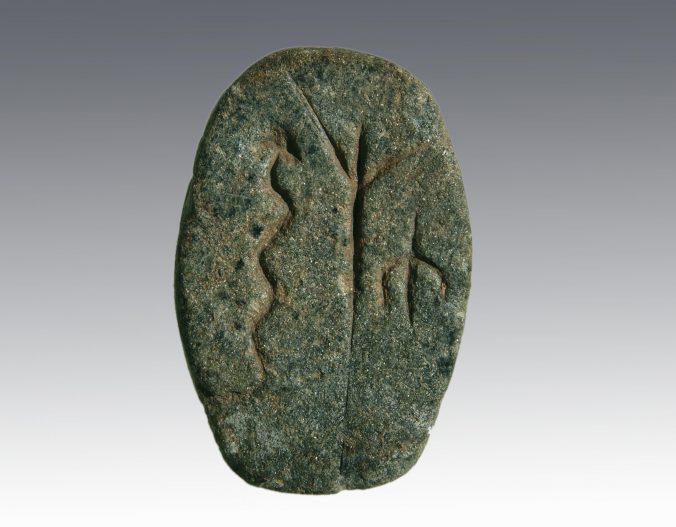A fascinating small plaquette discovered at Göbekli Tepe, one of the most mysterious and significant archaeological sites of the Neolithic period, has provided a glimpse into the spiritual and symbolic life of early human societies. This artifact features intricate depictions: a snake ascending, a stylized human figure with raised arms, and a bird in flight with extended wings. These symbols, while visually striking, also carry profound meanings that shed light on the complex belief systems of the time. The plaque’s iconography is thought to represent themes of life, rebirth, and transcendence—key elements in the cosmology of ancient cultures.

The snake is often associated with transformation and renewal in various ancient cultures, symbolizing cycles of life and death. The human figure with raised arms may have represented a ritualistic or spiritual role, indicating a connection to divine forces or ceremonial duties. Meanwhile, the bird, flying with extended wings, likely symbolizes freedom or a connection to the divine, as birds were frequently used in ancient iconography to represent the soul’s journey or divine messengers.
Connection with Tell Abr´3: Shared Symbols Across Time and Space
What makes this particular find even more intriguing is the near-identical nature of the motifs found at Tell Abr´3, an ancient site located in the Euphrates Valley in northern Syria. Both sites were inhabited during the same period, estimated to be between 9000-8000 BC and 2500 BC. The repetition of these symbols at two distant sites suggests a shared cultural or symbolic language. It raises the possibility of cross-cultural interactions or the transmission of symbolic knowledge between distinct communities in the ancient Near East.
The Role of Symbols in Early Human Societies
These recurring motifs invite us to reflect on the role of art and symbolism in early human societies. In a world without writing, symbolic representations likely served as powerful tools for communication, identity, and ritualistic practices. Göbekli Tepe, with its monumental stone structures and detailed carvings, is often regarded as one of the earliest known sites of ceremonial gathering or worship. The motifs on this small plaquette can be seen as a part of the broader cultural and spiritual framework that governed the lives of those who lived at Göbekli Tepe.

The discovery of these symbols adds to a growing body of evidence that suggests the inhabitants of Göbekli Tepe, as well as other contemporary cultures, had highly developed systems of spiritual and symbolic expression. These early societies did not just construct monumental architecture, but also created a complex visual language to express their cosmological beliefs and social hierarchies long before the invention of writing systems.
Symbolism as a Bridge Between Cultures
The similarities between the plaques at Göbekli Tepe and Tell Abr´3 further support the theory that early Neolithic societies, despite their technological limitations, were not isolated but were part of a larger, interconnected world. The transmission of symbols and artistic expressions between geographically distant sites highlights the possibility that cultural and spiritual ideas were shared, adapted, and communicated through visual media.
The cultural exchange may not have been instantaneous, but the reuse of similar iconography over such vast distances demonstrates that early humans were capable of maintaining shared values and beliefs across different communities. These early symbolic expressions laid the foundation for the more complex belief systems that would later shape the ancient Near East, influencing the development of civilizations and the cultures that would dominate the region for millennia.
Conclusion: Insights into Prehistoric Mindsets
The discovery of this symbolic plaquette from Göbekli Tepe enriches our understanding of early human culture and the sophisticated belief systems that predate written history. The recurring motifs found in both Göbekli Tepe and Tell Abr´3 provide invaluable insights into how prehistoric peoples viewed their world—how they communicated through shared symbols, expressed their spirituality, and structured their social identities.
These early symbolic expressions, though thousands of years old, reveal a profound connection between the ancient world and the modern one. The use of visual symbols for religious and spiritual communication continues to resonate in many cultures to this day. Through these discoveries, we are able to glimpse the profound depths of human creativity and intellectual development that laid the groundwork for the complex societies and civilizations that would follow.

